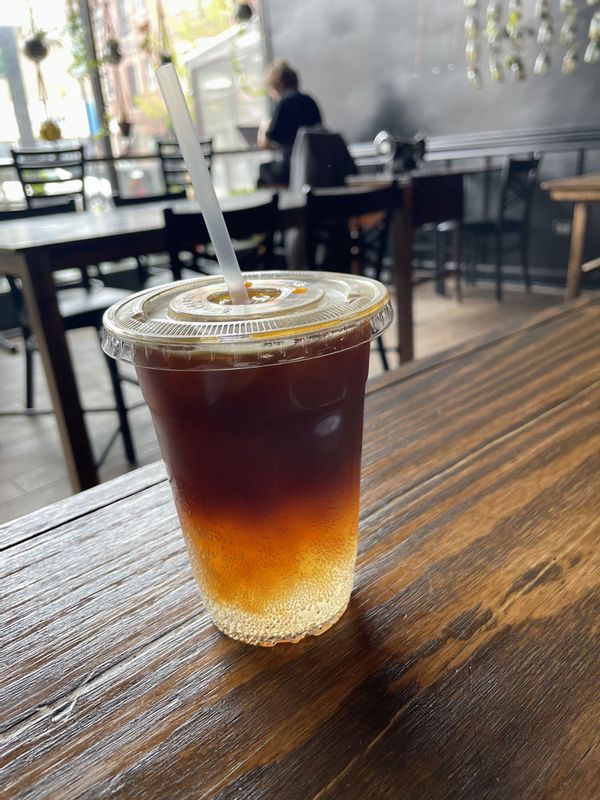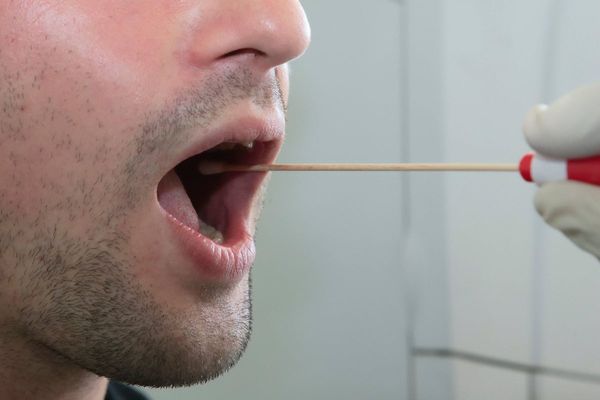
When I recently asked Erin Hoang, co-owner with sister Gigi Hoang of First Sip Cafe in Chicago's Uptown neighborhood, to share a summery coffee drink, she hesitated before offering up the cafe's spicy, refreshing — and blessedly two-ingredient — Ginger Americano. A variation on the espresso tonic that's shaping up to be the coffee drink of summer, First Sip's photogenic iteration blends two ounces of espresso with about 6 ounces of ginger beer.
"It looks really beautiful when you pour it, because the espresso sits on top of the ginger beer," Hoang told me as she passed me the two-toned sipper across the bar of her charming, plant-filled cafe.
Hoang's main concern when I requested the recipe was that most readers wouldn't be able to make espresso at home. (The manual makers available to most of us lack the intense pressurized steam of those glossy industrial machines, which is responsible for the intensity and concentrated flavors of the real deal.) She's right, of course, but I'm sharing her glorious recipe anyway.
But first, let's unpack espresso. Real espresso is not a bean blend or a roast color; it's a brewing method, in which highly pressurized hot water is forced over tamped coffee grounds to produce a concentrated coffee drink with a robust flavor and luscious, almost syrupy texture. It's equal parts chemistry and art, the product of a precise balancing of temperature, grind, pressure and barista know-how.
The first espresso machines were developed in the late 19th and early 20th century as a means to reduce coffee brewing times. More modern machines have vastly improved consistency and quality via computerized measurements and technical and pneumatic innovations. Still, the main components generally consist of the following: a steam generator boils water to create steam, a group head collects and pressurizes said steam, and a portafilter contains the basket that holds the grounds. To brew espresso, a combination of hot water and steam is pumped into the pressure chamber above the screen, which is then compressed to eight to 10 times that of normal atmospheric pressure, at a temperature just below boiling. The hot water is forced through a metal screen dotted with fine holes before it enters the puck of ground coffee, where it picks up the coffee;s flavor. The liquid passes through another set of small holes before it is finally funneled into the cup.
I've read that if I insist on replicating espresso at home without a machine (But why would anyone? They collectively say) the manual espresso maker is a good bet. Unfortunately, I'm a little afraid of the beautiful aluminum Bialetti Moka Express maker that was gifted to me some years ago. I dusted it off for our purposes, using my finicky stove and the instructions from the brand itself.
- Pour room-temperature water into the base until it reaches the safety valve.
- Fill the funnel generously with finely ground, high-quality coffee (I used an herby, chocolatey seasonal blend from Groundswell Coffee Roasters, my local roastery) without pressing down on it.
- Put the Moka on the stove, and set the flame to low.
- When you hear the gurgle, the coffee's ready. Remove it from the heat and pour.
The first batch came out burnt, mostly because my crappy gas range doesn't really have a "low" setting. The second was serviceable enough, but lacked the concentrated, syrupy punch of the real thing. I cleaned the Moka and set it back on its high shelf, in clear view of any guests who might question whether I'm cultured.
The truth is, I'm a French press coffee maker on most days. When I want a cappuccino, I go to my neighborhood coffee shop, where they pull a far better espresso than I ever could. Hence how I ended up researching whether I could brew passable espresso with a French press. Since I have no intentions of becoming a coffee chemist, I figured this would suffice for a homemade iced coffee drink.
"We only recommend [brewing espresso in a French press] as a last-resort option," chided Atlas Coffee Club, before divulging their method, which doesn't stray far from a standard French press brew, aside from the smaller grind size and lower water-to-bean ratio. I adapted the following method from bloggers and cookbook authors A Couple Cooks.
- Grind a scant ½ cup of high-quality coffee beans to a medium-fine grind (I used sweet and melony Intelligentsia Black Cat, which complements ginger beer nicely).
- Heat ¾ cup + 3 tablespoons filtered water to hot but not boiling (200 to 205 degrees F).
- Add the ground coffee to the French press. Pour about a tablespoon of the hot water over your grounds to bloom the coffee—or release the flavor notes of the beans. Let the grounds soak for about 30 seconds.
- Top the bloomed grounds with the rest of the hot water and stir. Set a timer and wait 4 minutes.
- Place the lid on the French press, and press the plunger about halfway down using slow, steady pressure. Raise the plunger back up to the top, then plunge all the way down using the same even pressure.
Does it come close to the real, viscous, deeply concentrated thing? No. But in a pinch, it works just fine for making a very concentrated cup of coffee — which is just what I needed for Ginger Espresso. On that note, the most important element when making these ill-advised forms of espresso is to freshly grind coffee from high-quality beans you genuinely enjoy the flavor of.

Now that you've come all this way for this two-ingredient coffee drink, I (finally) present First Sip's Ginger Americano, a lightly sweet and prickly refresher with bitter-edge roundness from the coffee and residual heat from the spicy ginger. It's the ideal bright-eyed lift on a sticky summer day.
Ginger Americano
From First Sip Cafe
Ingredients
Ice, as needed
Scant ½ cup (about 40 grams) of your favorite whole coffee beans
6.8 ounces ginger beer (or 1 bottle Fever Tree ginger beer)
Directions
- Fill a glass with ice.
- Brew 2 ounces of espresso using your preferred method.
- Pour the espresso over the ice. Add the ginger beer.
- Pause to enjoy its two-toned beauty. Stir, and sip.
Salon Food writes about stuff we think you'll like. While our editorial team independently selected these products, Salon has affiliate partnerships, so making a purchase through our links may earn us a commission.







